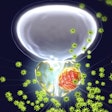
Lunit's artificial intelligence (AI) biomarker Scope IO may be effective in predicting clinical outcomes of immunotherapy in patients with advanced non-small cell lung cancer (NSCLC), according to a proof-of-concept study published on March 10 in the Journal of Clinical Oncology.
The Lunit Scope IO is an AI-powered whole-slide image (WSI) analyzer of tumor-infiltrating lymphocytes (TIL) in the tumor microenvironment. The software is designed to define three immune phenotypes (IPs): inflamed, immune-excluded, and immune-desert.
 Lunit's AI biomarker platform, Lunit SCOPE IO. Image courtesy of Lunit.
Lunit's AI biomarker platform, Lunit SCOPE IO. Image courtesy of Lunit.In the study, South Korean researchers tested the analyzer on slides from 518 NSCLC patients. Inflamed IP correlated with enrichment in local immune cytolytic activity, higher response rate, and prolonged progression-free survival compared with patients with immune-excluded or immune-desert phenotypes, according to the findings.
In addition, at the WSI level, there was significant positive correlation between tumor proportion score (TPS) as determined by the AI model and control TPS analyzed by pathologists, the researchers found.
"This is the first study that adopted AI technology to define the tumor immune phenotype, and to demonstrate its ability in predicting treatment outcomes of anti-PD-L1 therapy in two large cohorts of patients with advanced NSCLC," said co-senior author Dr. Tony Mok of the Chinese University of Hong Kong, in a news release from Lunit.
Company representatives noted that while TILs are promising biomarkers for predicting immunotherapy treatment outcomes apart from PD-L1, clinical application remains challenging. TIL quantification involves a manual evaluation process bound to practical limitations of interobserver bias and intensive labor, they stated.
Employing the computational capabilities of AI could open new possibilities for the objective quantification of TIL, Lunit said.



















